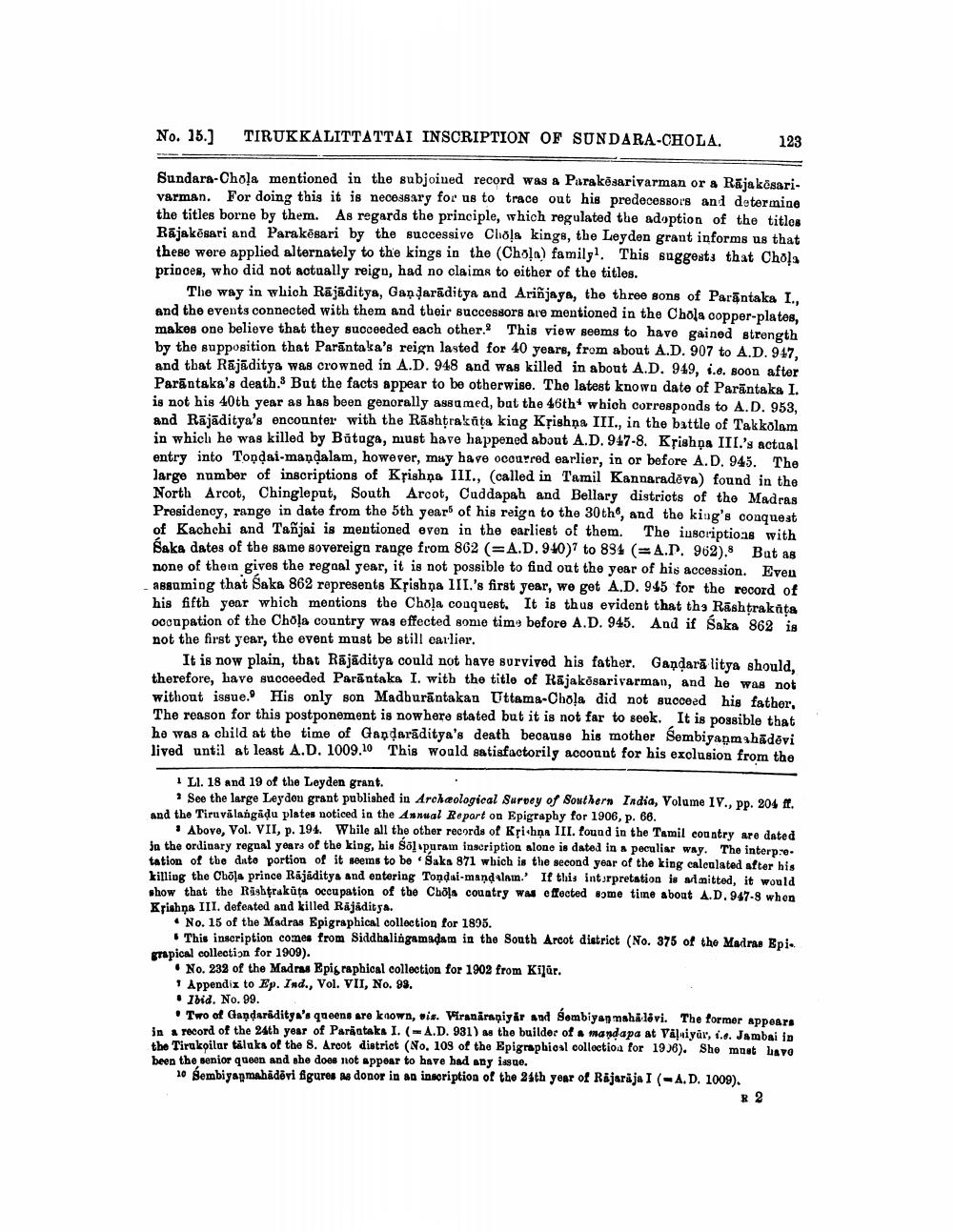________________
No. 15.)
TIRUKKALITTATTAI INSCRIPTION OF SUNDARA-CHOLA.
123
Bundara-Chola mentioned in the subjoined record was a Parakēsarivarman or a Rājakësarivarman. For doing this it is necessary for us to trace out his predecessors and determine the titles borne by them. As regards the principle, which regulated the adoption of the titles Rājakēsari and Parakösari by the successive Chola kings, the Leyden grant informs us that these were applied alternately to the kings in the (Chola) family. This suggests that Chola pripoes, who did not actually reigo, had no claims to either of the titles.
The way in which Rajāditya, Gandarāditya and Ariñjaya, the three sons of Parāntaka I.. and the events connected with them and their successors are mentioned in the Chola copper-plates, makes one believe that they succeeded each other. This view seems to have gained strength by the supposition that Parāntaka's reign lasted for 40 years, from about A.D. 907 to A.D. 917, and that Rājāditya was crowned in A.D. 948 and was killed in about A.D. 949, i.e. soon after Parāntaka's death. But the facts appear to be otherwise. The latest known date of Parāntaka I. is not his 40th year as has been genorally assumed, but the 46th which corresponds to A.D. 953, and Rājāditya's encounter with the Rashtrakāta king Kfishņa III., in the battle of Takkolam in which he was killed by Būtuga, must have happened about A.D. 947-8. Krishna III.'s actual entry into Tondai-mandalam, however, may have ocourred earlier, in or before A.D. 945. The large number of inscriptions of Krishna III., (called in Tamil Kannaradeva) found in the North Arcot, Chingloput, South Arcot, Cuddapah and Bellary districts of the Madras Presidency, range in date from the 5th years of his reign to the 30th, and the king's conquest of Kachchi and Tañjai is mentioned even in the earliest of them. The iuscriptions with Saka dates of the same sovereiga range from 862 (=A.D. 940)7 to 834 (=A.P. 962). Bat as none of thein gives the regoal year, it is not possible to find out the year of his accession. Even assuming that Saka 862 represents Kpishna 1II.'s first year, we get A.D. 945 for the record of his fifth year which mentions the Chola conquest. It is thus evident that the Rashtrakata og pation of the Chola country was effected sone time before A.D. 945. And if Saka 862 is not the first year, the event must be still carlier.
It is now plain, that Rājāditya could not have survived his father, Gandară litys should, therefore, have succeeded Parāntaka I. with the title of Kājakosarivarman, and he was not without issue. His only son Madburāntakan Uttama-Chola did not succeed his father, The reason for this postponement is nowhere stated but it is not far to seek. It is possible that he was a child at the time of Gandarāditya's death because his mother Sombiyanmahādēvi lived until at least A.D. 1009.10 This would satisfactorily account for his exclusion from the
1 LI. 18 and 19 of the Leyden grant.
See the large Leydou grant published in Archeological Survey of Southern India, Volume IV., pp. 204 ff. and the Tiruvălangadu plates noticed in the Annual Report on Epigraphy for 1906, p. 66.
Above, Vol. VII, p. 194. While all the other records of Krishna III. found in the Tamil country are dated In the ordinary regnal years of the king, his Sölpuram inscription alone is dated in a peculiar way. The interpretation of the dato portion of it seems to be Saka 871 which is the second year of the king calculated after his killing the Chola prince Rājāditys and entering Tondui-mandalam.' If this intrpretation is almitted, it would show that the Rashtrakūta occupation of the Chols country was effected some time about A.D. 947-8 when Krishna III. defeated and killed Rajaditya.
• No. 15 of the Madras Epigraphical collection for 1895.
. This inscription comes from Siddhalingamadam in the South Aroot district (No. 375 of the Madras Epi. gripical collection for 1909).
• No. 232 of the Madras Epigraphical collection for 1902 from Kfjár. 1 Appendix to Ep. Ind., Vol. VII, No. 93. • Ibid. No. 99.
• Two of Gandariditya's queens are known, wie. Viranäraņiyar and Sombiya mahilovi. The former appears in a record of the 24th year of Parantaks I. (- A.D. 931) as the builder of mandapa at Vapaiyur, 1... Jambai in the Tirukoilar taluks of the S. Arcot district (No. 109 of the Epigraphiesl collectioa for 1936). She most bayo been the senior queen and she does not appear to have had any issue. 20 Sembiya mahädôvi figures as donor in an inscription of the 24th year of Rajaraja I (-A.D. 1009).
# 2




